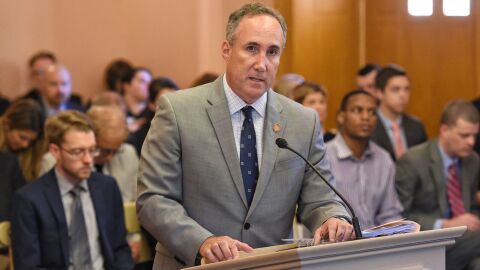The podcast Serial has called new attention to the power that local judges wield over everything from license suspensions to prison sentences.
“Judges in America are really the only elected public officials that the public invests with the authority to take their property, their liberty and sometimes even their life,” retired Cleveland Municipal Judge Ronald Adrine said.
There are more than a dozen contested judicial races on Cuyahoga County ballots this November, from the state supreme court down to the court of common pleas.
But despite judges’ influence over people’s lives, judicial races don’t get much attention.
Thousands Skip Judicial Contests
Two years ago, about 600,000 people voted in Cuyahoga County.
A lot of them—about 38 percent, on average, or 230,000 people—left their ballots blank when they got down to contested races for county common pleas judge.
“It’s not like judges are in the news every day,” Adrine said. “If you see us on TV, it’s for two or three seconds, when somebody really bad is in front of us. What can you get from that? What can you gauge from those short interactions? I’d say not very much.”
Adrine said he’s encountered people don’t know that much about the court system or the elected officials who run it.
Polling from the University of Akron bears this out. Four years ago, respondents who skipped judicial races told pollsters they did it largely because they didn’t know enough about the candidates.
“So even though they’re out there and they’re campaigning and you might hear ads about it,” University of Akron professor Phil Marcin said, “the information that voters receive—and it’s reinforced by this survey—is far less than the information they receive about the other offices.”
The university and Ohio Supreme Court Chief Justice Maureen O’Connor have tried to fill voters in. Their website, Judicial Votes Count, posts biographies submitted by the candidates themselves from all over the state.
In 2014, O’Connor proposed several reforms to judicial races: moving the contests to odd-numbered years, placing judges at the top of the ballot, educating voters on the candidates and raising judicial qualifications.
Currently, municipal judges are elected in odd years and the rest of the judiciary in even ones. Judicial candidates remain near the bottom of ballots.
Clearing Up Judicial Confusion
Candidates say they spend hours after work going to events and local political meetings to get voters to remember them. They put their names out with mailers and endorsements from the county parties and from labor unions.
But judicial candidate names can be confusing for voters. At a meeting in East Cleveland last month, Democratic candidate James W. Satola was introduced by the wrong last name—that of his Republican opponent, Common Pleas Judge Kathleen Ann Sutula.
The Plain Dealer editorial board has tried to call attention to judicial races. The board has campaigned for years against the so-called “name game,” the preponderance of certain last names in judicial contests.
“These Irish names and Italian last names and the last name of Brown, these are all very electable names in Cuyahoga County,” Elizabeth Sullivan, who leads the board for the paper and Cleveland.com, said.
In recent years, the board has published audio of candidate interviews along with the endorsements.
In Cuyahoga County, voters have an additional resource: Judge 4 Yourself, a ranking website run by the major bar associations.
Candidates answer a 14-page questionnaire, in which they submit samples of legal writing. They undergo questioning from dozens of attorneys with the Cleveland Metropolitan Bar Association, the Cuyahoga Criminal Defense Lawyers Association, the Ohio Women’s Bar Association and the Norman S. Minor Bar Association.
Defense attorney Tim Riley described it as sort of a job interview.
“When you’re in a room with 60 lawyers, they’re going to know what’s important to ask and what kind of judge this person is going to make, you know what I mean?” Riley said. “They’re going to be able to tell.”
What the public sees are the grades the bar associations give out—excellent, good, adequate or not recommended.
But a good ranking only goes so far. In November 2016, lower-ranked candidates won three out of six contested common pleas races in Cuyahoga County.
Sullivan said Judge 4 Yourself should do more to explain why candidates received the grades they did. The group’s leaders are now talking about how to do that while still having frank conversations, according to Riley.
“You want people to be very candid and open and honest about what they’re going to say,” Riley said. “You put that out in the newspaper, you may not get that.”
Judge 4 Yourself leaders are also talking about diversity, which Sullivan said is a problem in Cuyahoga County.
“Thirty-four judges on the general division bench, not a single Hispanic and not a single African-American male on the bench,” she said. “And there won’t be after this election, either, because there are no candidates.”
As for finding specific details about judges—such as what kinds of sentences they give out or how they conduct themselves in court—there are limited places to go.
“The only places that you can really look for substance are in the courtroom itself,” Adrine said.
That’s a place many voters don’t see.
Copyright 2021 90.3 WCPN ideastream. To see more, visit 90.3 WCPN ideastream. 9(MDA5NTM4MTIyMDE0MTg3NDc2MTVlZjdmNQ001))





